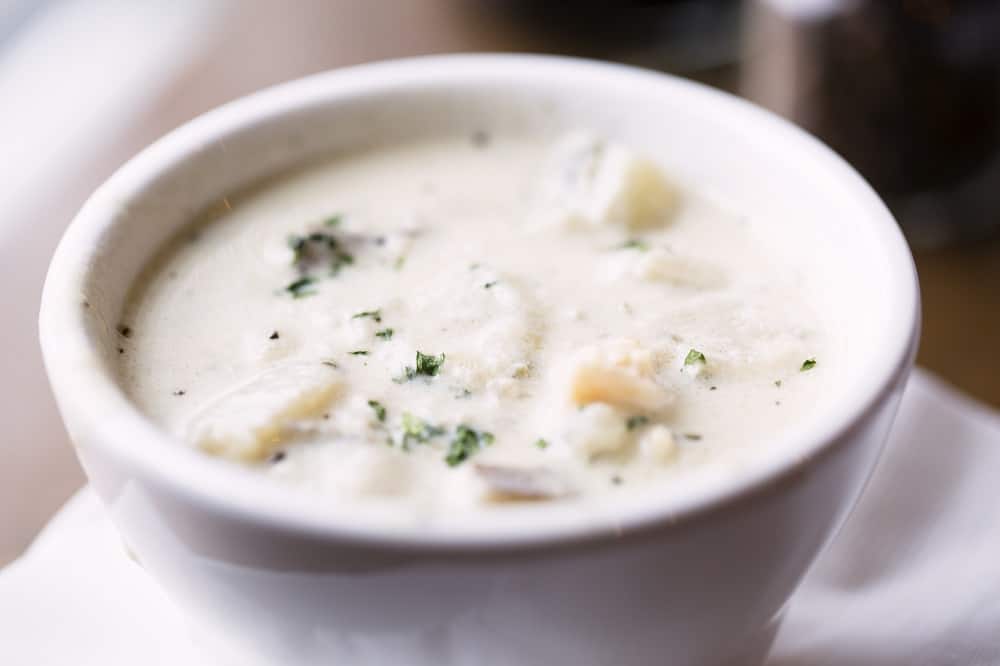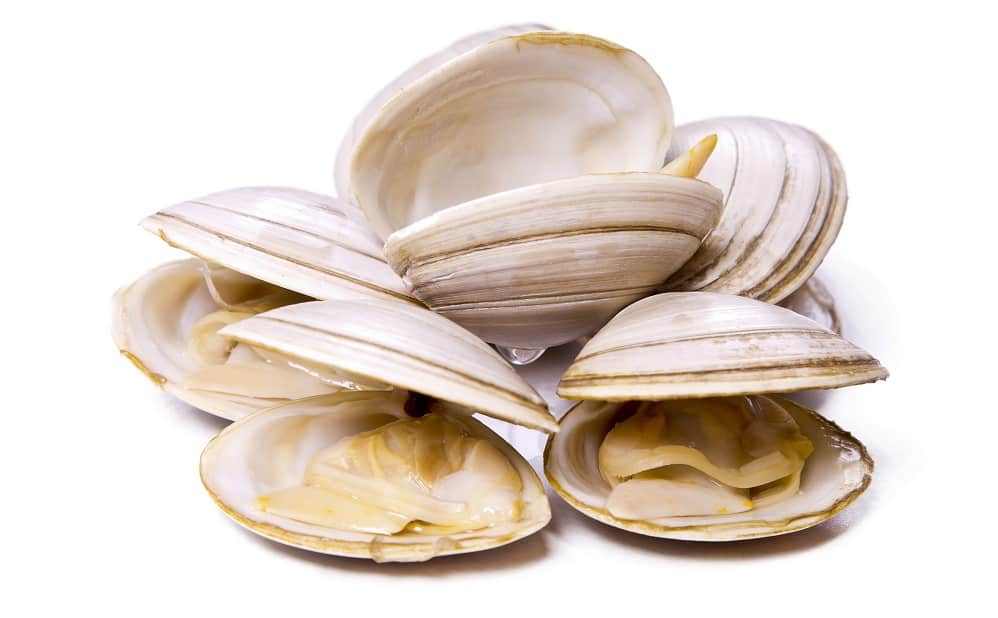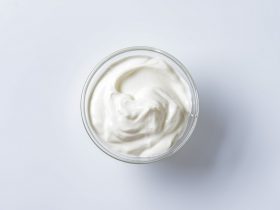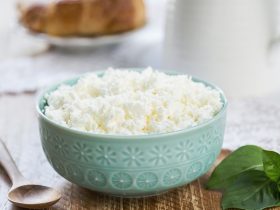Seafood dishes are great sources of protein, vitamins and essential omega-3 fatty acids. But choosing which types of seafood are safe to eat during pregnancy can be sometimes confusing. Shellfish, in particular, should be consumed with caution by pregnant women.
Clams are generally safe to eat during pregnancy as long as they were properly cooked. Cooking kills potential harmful bacteria that may be present in clams. Therefore, pregnant women can enjoy eating clam chowder provided that all ingredients used are also pregnancy-safe, like pasteurized milk and cream.
Seafood Intake During Pregnancy
Seafood is an excellent source of docosahexaenoic acid (DHA), eicosapentaenoic acid (EPA), vitamin D, selenium, and other nutrients. In adults, evidences suggest that consumption of seafood and the associated intake of omega-3 polyunsaturated fatty acids (PUFAs) can help maintain cardiovascular health (Hu et al., 2021).
Fish consumption has been shown to be associated with lower blood pressure, plasma triglycerides, resting heart rate and inflammation, as well as improvement of myocardial filling and efficiency, and vascular function (Hu et al., 2021). It also decreases risks of certain forms of heart disease in adults (Mahaffey et al., 2011).
During pregnancy, current data show that regular fish consumption can have potential benefits on the baby’s development (Hu et al., 2021). Arterburn et al. in 2006 noted that omega-3 PUFAs play a beneficial role in visual, mental and cardiovascular health throughout the human life cycle. Similarly, Mahaffey et al. in 2011 said that omega-3 fatty acids, in particular DHA, are beneficial to cognitive and visual system development in infants.
DHA is the principal omega-3 fatty acid in tissues and is especially abundant in neural and retinal tissues (Arterburn et al., 2006). Among the PUFAs, DHA has been shown to be preferentially transported across the placenta into fetal circulation. However, the exact mechanism for the selective accumulation of DHA in the brain is still unknown (Yavin et al., 2001).
There is limited storage of omega-3 PUFAs in adipose tissue, hence, a continued dietary supply is needed. Dietary DHA leads to a dose-dependent increase in plasma DHA concentration. A dose of about 2,000 milligrams per day is needed for maximum plasma response (Arterburn et al., 2006).
Seafood consumption in pregnancy is considered highly beneficial due to its EPA and DHA content (Yavin et al., 2001). These essential fatty acids are important for these functions (Yashodhara et al., 2009):
- Cell membrane formation, integrity and function
- Brain, retina, liver, kidney, adrenal gland, and gonadal function
- Local hormone production for regulation of blood pressure, and immune and inflammatory responses
Aside from improving fetal intellectual development, intake of omega-3 fatty acids during pregnancy also decreases the risk of preterm birth. According to the guidelines by the UK Scientific Advisory Committee on Nutrition, consumption of a minimum of 2 servings of seafood per week is needed to obtain these health benefits (Yashodhara et al., 2009).
Seafood consumption during pregnancy should, therefore, be promoted. The 2015-2020 Dietary Guidelines for Americans (DGA) recommends at least 8 ounces up to 12 ounces (or 2 to 3 servings) of seafood per week. Likewise, Canada’s Food Guide 2017 recommends pregnant women to choose high-protein foods and foods with healthy fats instead of saturated fat (Hu et al., 2021).
The most common sources of omega-3 PUFAs worldwide are fish and shellfish (Mahaffey et al., 2011). In 2007, Hibbeln et al. showed that maternal intake of seafood during pregnancy of less than 340 grams per week was associated with higher risk of children having the lowest quartile for verbal intelligence quotient (IQ), compared with women who ate more than 340 grams per week.
Low maternal consumption of seafood was likewise associated with higher risk of suboptimum outcomes for prosocial behavior, fine motor, communication, and social development scores. Therefore, the risks from nutrient loss with low seafood intake were greater than the risks of harm from possible contaminant exposure with high seafood intake (Hibbeln et al., 2007).
In 2008, Oken et al. likewise demonstrated that pregnant mothers with the highest quartile of fish consumption during pregnancy, compared to those with intake at the lowest quartile, had higher child developmental scores at 18 months.
What is Clam Chowder?

Chowder means rich, thick soup. Unlike other pureed soup, chowders are characteristically served with their chunky ingredients intact. Currently, popular types of chowder include corn, fish, lobster, mussel, crab, shrimp, salmon and clam.
Learn More: Can You Eat Shrimp Cocktail While Pregnant?
New England Clam Chowder
Also called Boston clam chowder, the New England clam chowder is considered the best-tasting and most popular type of clam chowder. It is prepared with a milk or cream base, which makes the soup thick and color white. Other ingredients added with the clams are potatoes, onions, celery, salt and pepper.
Manhattan Clam Chowder
The Manhattan clam chowder is contrastingly red because of its tomato base. It typically includes more vegetables and usually can consist of green peppers and carrots in addition to those seen in the New England clam chowder.
Rhode Island Clam Chowder
The Rhode Island clam chowder is typically made with a clear broth, though a bit of tomato puree can occasionally also be used to create a red broth. In both cases, the soup is thin in consistency. Another difference is the traditional use of quahog clams for this style of clam chowder.
Safety of Eating Clam Chowder During Pregnancy
Clams contain 240 milligrams of EPA and DHA combined per 100 grams (Mahaffey et al., 2011). Clam chowder is one of the most popular ways of eating clams. It is safe for pregnant women to eat as long as other ingredients (pasteurized milk and cream) used are also pregnancy-safe.
Cooking the clam thoroughly in a soup will kill any potential bacteria present. According to the NHS, cooked shellfish, such as mussels, lobster, crab, prawns, scallops and clams, are safe to eat during pregnancy.
According to the Interstate Shellfish Sanitation Conference, “fully cooked” clams should adhere to the following methods of cooking:
- Boiled (including soup or chowder) – cooked for at least 3 minutes
- Fried – cooked for at least 3 minutes at 190oC or 375oF
- Broiled or grilled – cooked three inches from the heat for 3 minutes
- Oven baked – cooked for ten minutes at 230oC or 450oF
- Steamed – cooked for 5 to 10 minutes when the water is already steaming (depends on the size of the clam)
Raw clams, on the other hand, should be avoided by pregnant women because they can have harmful bacteria like Vibrio vulnificus, that can cause food poisoning and lead to severe illness and death. Vibrio vulnificus is naturally found in coastal waters and can be found in waters approved for clam harvesting. It does not change the appearance, taste or odor of clams.
Symptoms of an infection with Vibrio vulnificus include:
- Vomiting
- Diarrhea
- Stomach aches
- Severe weakness
- Skin rash and blister
- Chills
- High fever
Most bacteria that can cause food borne illnesses, including Vibrio vulnificus, can be killed by cooking. Therefore, it is important to never eat raw clams and always choose properly cooked clams when dining out.
Potential Dangers from Eating Clams

Food Borne Infections
Domoic Acid
Domoic acid is a potent neurotoxin (Costa et al., 2010) that can accumulate in shellfish, such as crabs, mussels, razor clams, and scallops, and cause amnesic shellfish poisoning (ASP). The neurotoxicity of domoic acid is related to neuronal degeneration and necrosis in specific regions of the hippocampus, leading to hallucinations, memory loss and coma (Jeffery et al., 2004).
Exposure to low levels of domoic acid can lead to gastrointestinal effects, but higher levels can cause neurological symptoms, including seizure, memory impairment, and limbic system degeneration. Domoic acid exposure to humans primarily occurs through consumption of contaminated shellfish like mussels and clams (Costa et al., 2010).
Domoic acid also accumulates in anchovies, sardines, mackerel and albacore, but in levels that are usually lower than that found in shellfish (Lefebvre et al., 20002). It is also important to note that cooking does not reduce the concentration of domoic acid in shellfish (McCarron & Hess, 2006).
Clostridium Botulinum
Clostridium botulinum rarely causes illness in humans from food consumption because refrigeration of foods effectively prevents its germination and toxin production. However, improper food handling can still lead to infection (Sobel et al., 2004).
In 2004, Sobel et al. reported an outbreak of botulism type A caused by a commercially produced clam chowder. It happened in California in 1994 and affected two persons who failed to refrigerate the product for storage before consumption.
Toxoplasma Gondii
Consumption of contaminated, uncooked shellfish is a potential source of human infection with Toxoplasma gondii. In 2009, Jones et al. showed that eating raw oysters, clams or mussels is a risk factor for Toxoplasmosis. Similarly, two independent risk factors for acute Toxoplasmosis found by Chiang et al. in 2014 were raw clam consumption and having a cat in the household.
The most common clinical manifestations of Toxoplasmosis are flu-like symptoms, followed by central nervous system disease, ocular diseases, abortion, and congenital infection. Toxoplasma gondii can infect humans through three major transmission routes (Chiang et al., 2014):
- Food consumption of meat infected by tissue cysts
- Animal to human transmission through ingestion of oocysts shed in the feces of infected cats
- Mother to fetus transmission during pregnancy through placental transfer and congenital infection
Acute Toxoplasmosis can lead to self-limiting flu-like symptoms or lymphadenopathy. However, life-threatening disease can also occur, with encephalitis, chorioretinitis (ocular disease with impaired vision), pneumonia, or multi-organ involvement. Congenital Toxoplasmosis can cause intracranial and ocular lesions in babies, which may lead to mental retardation or blindness (Chiang et al., 2014).
Women of childbearing age should be encouraged to avoid risk factors for Toxoplasma infection to decrease the risk for congenital Toxoplasmosis (Lopes et al., 2012).
Viruses
Raw or undercooked shellfish, including oysters, clams, mussels and cockles, can accumulate viruses within their edible tissues. Outbreaks of Norovirus and Hepatitis A virus have been reported after consumption of contaminated shellfish (Richards, 2016).
According to the Centers for Disease Control and Prevention (CDC), Noroviruses are the most common cause of acute food borne gastroenteritis in the United States (Scallan et al., 2011; Hall et al., 2012). In 2005, Hamano et al. reported food borne gastroenteritis outbreaks associated with Norovirus from eating contaminated shellfish in Japan. In 2016, Richards likewise demonstrated the experiences of New York and Japan with Norovirus outbreaks related to raw and steamed clams.
Numerous outbreaks of hepatitis A associated with consumption of contaminated clams have occurred in the United States and Europe. Thorough cooking can inactivate enteric viruses, hence clams associated with outbreaks appeared to be raw or not fully cooked (Richards, 2016).
An outbreak of hepatitis A associated with consumption of coquina clams in Spain was cited in two different studies (Bosch et al., 2001; Sanchez et al., 2002). Hepatitis A virus was detected in up to 75% of assayed samples of shellfish (Bosch et al., 2001).
In 2002, Kingsley et al. detected both Hepatitis A virus and Norovirus in clams that were labeled “cooked” but appeared raw. In 2003, Furuta et al. reported a food poisoning outbreak associated with both Norovirus and Hepatitis A virus, following consumption of steamed purple Washington clams.
Exposure to Mercury
Mercury is commonly found in fish and shellfish. It is a known neurotoxin that is able to readily cross the placenta and reach fetal circulation. Fetal levels of mercury have been found to be even greater than maternal levels (Ding et al., 2013). Mercury is responsible for destruction of microtubules, damage to mitochondria, lipid peroxidation and accumulation of neurotoxic molecules, including serotonin, aspartate and glutamate (Patrick, 2002).
The mercury content of clams is 0.01 milligram per 1,000 grams (Mahaffey et al., 2011). According to the U.S. Food and Drug Administration (FDA), the average mercury concentration of clams is 0.009 parts per million (ppm). This is a minimal level, compared to the standard 0.1 ppm considered as “low” mercury content.
According to the Environmental Defense Fund (EDF), mercury level is low across clam types and species that include the following:
- Ocean and Northern Quahogs
- Farmed and Wild Pacific Geoduck Clams
- Farmed Pacific Littleneck Clams
- Farmed Blood Cockles
- Softshell Clams
- Wild Atlantic Sufclams
- Butter Clams
- Farmed Manila Clams
- Steamer Clams
Tips for Eating Seafood During Pregnancy
Avoid Eating Raw Seafood
Raw or undercooked seafood may contain harmful pathogens that can cause food borne illnesses like Listeriosis, Toxoplasmosis and Salmonella infections. Therefore, avoid raw fish and shellfish, including sushi, sashimi, ceviche and raw oysters, scallops or clams. Also avoid eating seafood labeled as nova style, lox, kippered, smoked or jerky, as these are all uncooked.
Smoked seafood is safe to eat only when used as an ingredient for cooked dishes. Cook fish to an internal temperature of 145oF or 63oC. Fish is cooked when it separates into flakes and appears opaque throughout.
Boil shellfish for 3 to 5 minutes after the shells open. Discard any that do not open during cooking. Do not cook too many shellfish in one pot because those in the middle may not get properly cooked.
Avoid Eating Seafood That is High in Mercury Content
Seafood can contain variable amounts of mercury, a well-known and widespread environmental neurotoxicant that is harmful for fetal brain development. Majority of cases of mercury exposure to humans happen through consumption of seafood (Mahaffey et al., 2011). Fetuses are at greatest risk because the developing brain is particularly susceptible to the harmful effects of mercury exposure in utero (Oken et al., 2005).
Bigger, older and higher trophic-level seafood species generally have higher mercury content than smaller, younger and lower trophic-level species. Concentrations of mercury in top predator fish can be up to 10 million times higher than in the water. Levels of mercury in fish and shellfish reflect the concentrations in their diet (prey), level of contamination in the water from which they were harvested, and physiological factors like metabolism and growth rate (Mahaffey et al., 2011).
In 2005, Oken et al. observed that increased consumption of fish during pregnancy was associated with improved infant cognition, but higher levels of mercury exposure were associated with lower infant cognition. In 2008, Davidson et al. demonstrated a direct association between maternal exposure to mercury and lower mean Psychomotor Developmental Index (PDI) scores in their offspring at 30 months of age. It is therefore important to choose seafood species that are high in omega-3 fatty acids but low in mercury content (Mahaffey et al., 2011).
The U.S. FDA recommends avoiding the following seafood during pregnancy due to their high mercury content:
- Bigeye tuna
- Swordfish
- King mackerel
- Tilefish
- Shark
- Marlin
- Orange roughy
Be a Picky Eater
Being pregnant gives women the right to be picky when it comes to the food they eat. It is important to find out how seafood dishes for consumption are prepared prior to eating. Make sure that all fish and shellfish have been properly cooked.
Consult local guidelines and shellfish advisories when catching seafood from local waters. Check if there have been reports of contamination. If there are any, avoid eating seafood from these sources and choose farmed ones instead, where contaminants are controlled and routinely tested for.
Ensure Proper Handling of Seafood
Safe handling, preparation and storage are equally important:
- Wash all cutting boards, knives and areas used for preparing raw seafood with water and soap.
- Use separate knives and cutting boards for raw seafood.
- Store leftover food in airtight containers in the refrigerator or freezer.
- Food that has been left at room temperature for more than two hours should be discarded.
- Perishable, precooked or leftover food that has not been consumed after four days should be discarded.
- Wash hands thoroughly before and after handling seafood.
Final Thoughts
Pregnant women should aim for 8 to 12 ounces (or 2 to 3 servings) of seafood intake per week from choices that have lower mercury content. This will ensure proper fetal brain development from adequate amounts of omega-3 fatty acids, in particular, DHA and EPA.
Clam chowder is a low mercury type of seafood dish that can be safely consumed during pregnancy as long as it is fully cooked. Pregnant women should also go for a variety of seafood types. Ask your doctor if you have questions about seafood dietary consumption.
References
- https://www.healthline.com/health/pregnancy/crab-and-seafood
- https://www.issc.org/risks-of-eating-raw-oysters-or-clams
- https://www.nhs.uk/pregnancy/keeping-well/foods-to-avoid/
- https://www.fda.gov/food/metals-and-your-food/mercury-levels-commercial-fish-and-shellfish-1990-2012
- https://www.mayoclinic.org/healthy-lifestyle/pregnancy-week-by-week/in-depth/pregnancy-nutrition/art-20043844
- https://www.wise-geek.com/what-is-clam-chowder.htm
- https://www.captainbenjamins.com/blog/the-different-styles-of-clam-chowder-explained
- Arterburn, L., Hall, E. B., & Oken, H. (2006). Distribution, interconversion, and dose response of n-3 fatty acids in humans. The American Journal of Clinical Nutrition 83(6 Suppl), 1467S-1476S. doi: 10.1093/ajcn/83.6.1467S
- Bosch, A., Sanchez, G., Le Guyader, F., Vanaclocha, H., Haugarreau, L., & Pinto, R. M. (2001). Human enteric viruses in Coquina clams associated with a large hepatitis A outbreak. Water Science and Technology 43(12), 61-65. https://pubmed.ncbi.nlm.nih.gov/11464770/
- Chiang, T., Kuo, M., Chen, C., Yang, J., Kao, C., Ji, D., & Fang, C. (2014). Risk factors for acute Toxoplasma gondii diseases in Taiwan: A population-based case-control study. PLoS One 9(3), e90880. doi: 10.1371/journal.pone.0090880
- Costa, L., Giordano, G., & Faustman, E. (2010). Domoic acid as a developmental neurotoxin. Neurotoxicology 31(5), 409-423. doi: 10.1016/j.neuro.2010.05.003
- Davidson, P., Strain, J. J., Myers, G., Thurston, S., Bonham, M., Shamlaye, C., …, & Clarkson, T. (2008). Neurodevelopmental effects of maternal nutritional status and exposure to methylmercury from eating fish during pregnancy. Neurotoxicology 29(5), 767-775. doi: 10.1016/j.neuro.2008.06.001
- Ding, G., Cui, C., Chen, L., Gao, Y., Zhou, Y. Shi, R., & Tian, Y. (2013). Prenatal low-level mercury exposure and neonatal anthropometry in rural northern China. Chemosphere 92(9), 1085-1089. doi: 10.1016/j.chemosphere.2013.01.045
- Furuta, T., Akiyama, M., Kato, Y., & Nishio, O. (2003). A food poisoning outbreak caused by purple Washington clam contaminated with norovirus (Norwalk-like virus) and hepatitis A virus. Kansenshogaku Zasshi 77(2), 89-94. doi: 10.11150/kansenshogakuzasshi1970.77.89
- Hall, A., Eisenbart, V., Etingue, A. L., Gould, L. H., Lopman, B., & Parashar, U. (2012). Epidemiology of foodborne norovirus outbreaks, United States, 2001-2008. Emerging Infectious Diseases 18(10), 1566-1573. doi: 10.3201/eid1810.120833
- Hamano, M., Kuzuya, M., Fujii, R., Ogura, H., & Yamada, M. (2005). Epidemiology of acute gastroenteritis outbreaks caused by noroviruses in Okayama, Japan. Journal of Medical Virology 77(2), 282-289. doi: 10.1002/jmv.20455
- Hu, X. F., & Chan, H. M. (2021). Seafood consumption and its contribution to nutrients intake among Canadians in 2004 and 2015. Nutrients 13(1), 77. doi: 10.3390/nu13010077
- Jeffery, B., Barlow, T., Moizer, K., Paul, S., & Boyle, C. (2004). Amnesic shellfish poison. Food and Chemical Toxicology 42(4), 545-557. doi: 10.1016/j.fct.2003.11.010
- Jones, J., Dargelas, V., Roberts, J., Press, C., Remington, J., & Montoya, J. (2009). Risk factors for Toxoplasma gondii infection in the United States. Clinical Infectious Diseases 49(6), 878-884. doi: 10.1086/605433
- Hibbeln, J., Davis, J., Steer, C., Emmett, P., Rogers, I., Williams, C., & Golding, J. (2007). Maternal seafood consumption in pregnancy and neurodevelopmental outcomes in childhood (ALSPAC study): An observational cohort study. Lancet 369(9561), 578-585. doi: 10.1016/S0140-6736(07)60277-3
- Kingsley, D., Meade, G., & Richards, G. (2002). Detection of both hepatitis A virus and Norwalk-like virus in imported clams associated with food-borne illness. Applied and Environmental Microbiology 68(8), 3914-3918. doi: 10.1128/aem.68.8.3914-3918.2002
- Lefebvre, K., Bargu, S., Kieckhefer, T., & Silver, M. (2002). From sanddabs to blue whales: The pervasiveness of domoic acid. Toxicon 40(7), 971-977. doi: 10.1016/s0041-0101(02)00093-4
- Lopes, A. P., Dubey, J. P., Moutinho, O., Gargate, M. J., Vilares, A., Rodrigues, M., & Cardoso, L. (2012). Seroepidemiology of Toxoplasma gondii infection in women from the North of Portugal in their childbearing years. Epidemiology and Infection 140(5), 872-877. doi: 10.1017/S0950268811001658
- Mahaffey, K., Sunderland, E., Chan, H. M., Choi, A., Grandjean, P., Marien, K., …, & Yasutake, A. (2011). Balancing the benefits on n-3 polyunsaturated fatty acids and the risks of methylmercury exposure from fish consumption. Nutrition Reviews 69(9), 493-508. doi: 10.1111/j.1753-4887.2011.00415.x
- McCarron, P., & Hess, P. (2006). Tissue distribution and effects of heat treatments on the content of domoic acid in blue mussels, Mytilus edulis. Toxicon 47(4), 473-479. doi: 10.1016/j.toxicon.2006.01.004
- Oken, E., Osterdal, M. L., Gillman, M., Knudsen, V., Halldorsson, T., Strom, M., …, & Olsen, S. (2008). Associations of maternal fish intake during pregnancy and breastfeeding duration with attainment of developmental milestones in early childhood: A study from the Danish national birth cohort. The American Journal of Clinical Nutrition 88(3), 789-796. doi: 10.1093/ajcn/88.3.789
- Oken, E., Wright, R., Kleinman, K., Bellinger, D., Amarasiriwardena, C., Hu, H., …, & Gillman, M. (2005). Maternal fish consumption, hair mercury, and infant cognition in a U.S. cohort. Environmental Health Perspectives 113(10), 1376-1380. doi: 10.1289/ehp.8041
- Patrick, L. (2002). Mercury toxicity and antioxidants: Part 1: Role of glutathione and alpha-lipoic acid in the treatment of mercury toxicity. Alternative Medicine Review 7(6), 456-471. https://pubmed.ncbi.nlm.nih.gov/12495372/
- Richards, G. (2016). Shellfish-associated enteric virus illness: Virus localization, disease outbreaks and prevention. Viruses in Foods, 185-207. doi: 10.1007/978-3-319-30723-7_7
- Sanchez, G., Pinto, R., Vanaclocha, H., & Bosch, A. (2002). Molecular characterization of hepatitis A virus isolates from a transcontinental shellfish-borne outbreak. Journal of Clinical Microbiology 40(11), 4148-4155. doi: 10.1128/jcm.40.11.4148-4155.2002
- Scallan, E., Hoekstra, R., Angulo, F., Tauxe, R., Widdowson, M., Roy, S., …, & Griffin, P. (2011). Foodborne illness acquired in the United States: Major pathogens. Emerging Infectious Diseases 17(1), 7-15. doi: 10.3201/eid1701.p11101
- Sobel, J., Tucker, N., Sulka, A., McLaughlin, J., & Maslanka, S. (2004). Foodborne botulism in the United States, 1990-2000. Emerging Infectious Diseases 10(9), 1606-1611. doi: 10.3201/eid1009.030745
- Yashodhara, B. M., Umakanth, S., Pappachan, J. M., Bhat, S. K., Kamath, R., & Choo, B. H. (2009). Omega-3 fatty acids: A comprehensive review of their role in health and disease. Postgraduate Medical Journal 85(1000), 84-90. doi: 10.1136/pgmj.2008.073338
- Yavin, E., Glozman, S., & Green, P. (2001). Docosahexaenoic acid sources for the developing brain during intrauterine life. Nutrition and Health 15(3-4), 219-224. doi: 10.1177/026010600101500411




